Man-controlled torpedo SSB (Italy)
In general, SLC torpedoes arranged for the fleet, but they were not without flaws. Inadequate speed and range, low usability of the crew and other features were noted. At the end of 1942, the command of the 10th light flotilla (10th MAC flotilla) expressed a desire to get a new human-controlled torpedo with fairly high performance, but devoid of the shortcomings of existing equipment. This task was set for specialists of the Office of the Underwater Arms of the Italian Navy (La Spezia). The direct developers of the project were Major Mario Mashulli and Captain Travalini. For several months they studied the experience of operating existing torpedoes and created a new project.
The new human-controlled torpedo is called SSB (Siluro San Bartolomeo - “Torpedo from San Bartolomeo”). It is noteworthy that the new project was not named in honor of its immediate "homeland", but received the name of the city in which the torpedoes of the previous model were created and assembled. In some sources, an SSB torpedo is referred to as the Mark II. The name Mark I in this case gets the previous SLC unit. However, such designations are not related to the original Italian nomenclature. The new project was originally supposed to be based on the ideas and decisions of the previous one. Nevertheless, in the course of studying the prospects of various proposals, it was found that the new torpedo should be seriously different from the existing one.
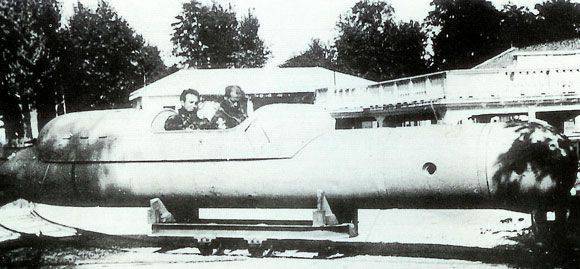
At the beginning of 1943, the first prototype of an SSB product was built, which was soon put to the test. The climate of Italy allowed to conduct sea trials all year round, which to some extent helped the creators of the new torpedo. By the beginning of summer, all checks and improvements were completed, after which the fleet ordered several serial torpedoes of the new model.
SSB torpedoes' serial construction lasted for several months. Until the beginning of autumn 1943, when the Kingdom of Italy capitulated, three torpedoes of the new model were built and transferred to the 10-th flotilla. Soon came the so-called. The Italian social republic, which continued to fight on the side of Nazi Germany. A number of formations of the Italian armed forces, including the MAC 10 fleet, retained their position in the conflict, moving into submission to the new puppet state. Already after the formation of the “Republic of Salo,” industrial enterprises and fleet experts collected eight SSB torpedoes. In addition, a batch of 16 torpedoes was ordered to Caproni. By the end of 1944, the Italian command wanted to have an SSB 24 in service.
Torpedo Maiale was developed on the basis of existing products, which consisted of the Italian Navy. To simplify the design, it was decided to install a set of special equipment on the existing 533-mm torpedo, which allowed to place the crew and control the work of various systems. The SSB project was also based on the existing torpedo, but this time it was necessary to use the base product of a different model.
The saboteurs of the 10 flotilla noted the low convenience of working on the SLC torpedo in combat conditions. The reason for the claims were the various features of this device, from low speed to uncomfortable improvised seats. Indeed, the divers had to sit astride the metal pipe of the hull, which was not equipped with any semblance of a seat. In addition, because of the low speed, the road to the goal could take several hours. All this should be taken into account in the new project.
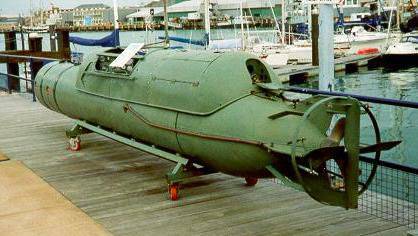
SSB Museum Torpedo
The basis for the work again took the existing torpedo, but differed in large caliber. Because of this, the cylindrical part of the SSB torpedo case had a diameter of about 0,8 m. On the upper surface of the case there was a special casing-fairing protecting the crew. Taking into account this detail, the height of the torpedo was 1,08 m. The total length of the torpedo, depending on the type of warhead, reached 7,3-7,5 m. The unit, ready for operation, weighed at least 2,2 t.
The idea of locating and using a warhead “migrated” to the SSB project from the previous SLC. To accommodate the explosive charge, it was proposed to use a nose fairing. In the course of the combat mission, the entire fairing should have been dropped. Initially, the SSB torpedo carried one charge with 300 kg of explosives. Later, an updated version of the warhead with an elongated body and a 400-kg charge appeared. Also developed a warhead consisting of two units with 180 or 200 kg of explosives in each.
A ballast tank was located behind the warhead in the hull, the filling control of which was carried out by the commander. Behind the ballast tank was a common crew cabin, with a characteristic casing on top. The authors of the project took into account the wishes of saboteurs, which affected the location of crew jobs. In the case of the SLC, the divers had to go "on horseback" on the torpedo. The SSB unit received a full-fledged cabin, placed inside the hull. Under the accommodation of the crew and equipment of his workplaces was given the entire middle part of the body. Various pipelines, cables, etc. passed along the sides.
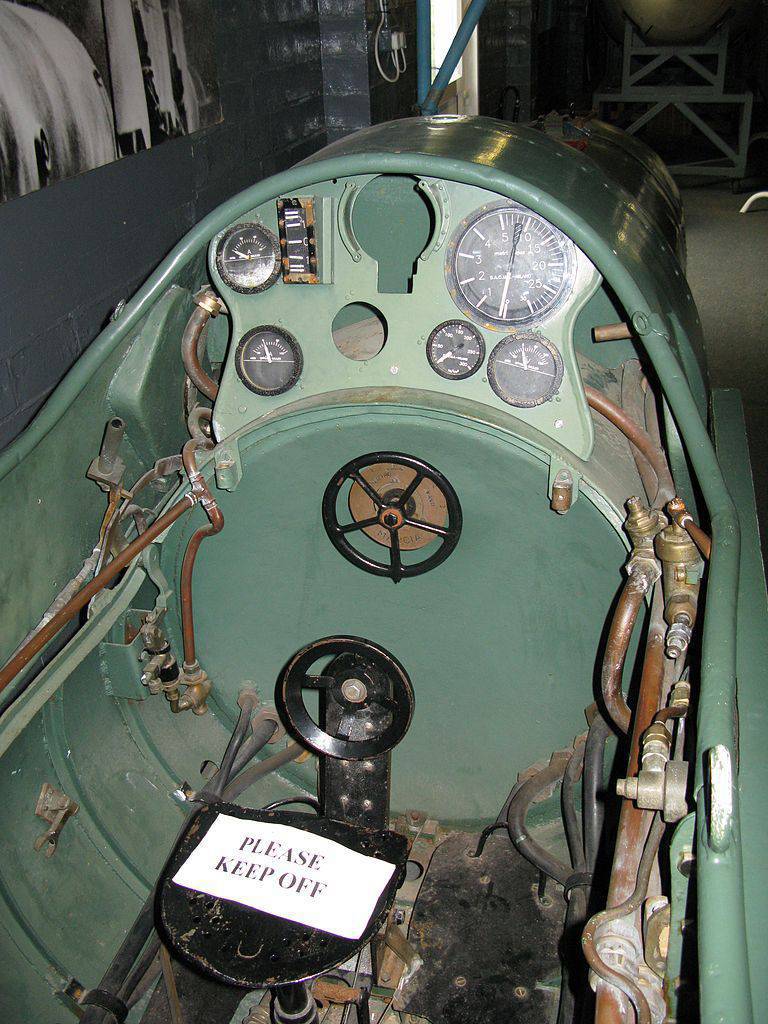
Cab torpedoes, the workplace commander-driver. Photo of Wikimedia Commons
While driving, the crew should be located on small stool seats. Before the place of the commander-driver was located the steering wheel associated with the stern rudders. With the help of the wheel, the commander could control the torpedo at the rate and depth. To monitor the operation of the systems, he had to use several instruments placed on the dashboard. There were a compass, depth gauge and other devices.
In the stern of the upper shell, a place was provided for the installation of compressed air cylinders for purging the ballast tank. Access to them was carried out through the hatch in the casing. Inside the aft hull housed all units of the power plant. The SSB torpedo was equipped with several rechargeable batteries and an HP 7,5 electric motor. It was expected that the engine of increased power (on the SLC was an engine with an 1,6 horsepower) would give a heavier torpedo the required characteristics. From the cone-shaped aft hull out the propeller shaft. Behind the screw were located the rudders and depth. Side screw protected by a special metal ring.
The human-controlled torpedo Siluro San Bartolomeo could reach speeds up to the 4,5 node. In this case, the battery charge was enough only for 4 sea miles of the way. Cruising speed was the 2,3 knot. At this speed, you could go up to 75 miles. The design of the torpedo allowed to dive to a depth of 30 m.
The crew of the torpedo should use the existing diving suits (Belloni costumes) and closed-type breathing apparatus. The latter included an oxygen cylinder with a gas reserve for 6 hours, a rubber bag, a cartridge with an absorbing compound and a mask with a tube. Oxygen was fed into the bag, from where it entered the mask of a diver. The exhaled gas mixture passed through a cartridge with a special compound that absorbed carbon dioxide, and then returned to the bag. This design of the breathing apparatus allowed to work for several hours without posing as bubbles of exhaled gases.
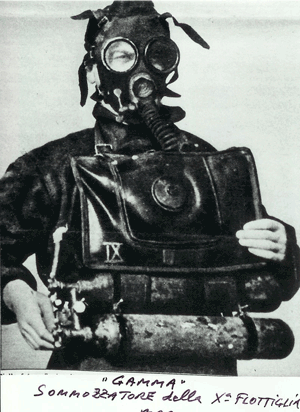
Saboteur with respiratory system
The proposed method of combat use of human-guided torpedoes SSB looked as follows. The torpedoes, placed in special containers on the deck of the submarine carrier, were to be delivered to the target area. Upon arrival at a given point, the commander of the operation had to give the necessary instructions to the saboteurs, after which they could prepare and exit through the airlock beyond the submarine. Then he had to open the container, take out the torpedo, check it, start the engine and go to the target.
In case the enemy used anti-submarine barriers, the crew of the Torpedo from San Bartolomeo had cutters, net lifters and other special equipment. The task of the crew was to deliver the warhead to the target. To conduct sabotage should get to the bottom of the enemy ship. On the side keels of the target, the saboteurs were supposed to fasten special clips connected by a strong cable. The combat unit was suspended on the cable, and the fuse with a clockwork mechanism was cocked. After that, the saboteurs could return to the submarine carrier. When using an SSB torpedo with one warhead, one cable was suspended under the bottom of the target. For the double warhead, in turn, should use two cables.
The experience of using SLC Maiale torpedoes showed high prospects for such weapons subject to the absence of problems with the material part. Even the 220-kg combat unit of the previous torpedoes could cause great damage to the enemy ship. The new SSB torpedo was supposed to carry a heavier warhead with corresponding sad consequences for the target ships. In addition, of great interest was the double warhead, which consisted of two separate charges weighing 180 and 200 kg. A similar version of the weapon in theory allowed us to immediately make two holes in the bottom of the target.
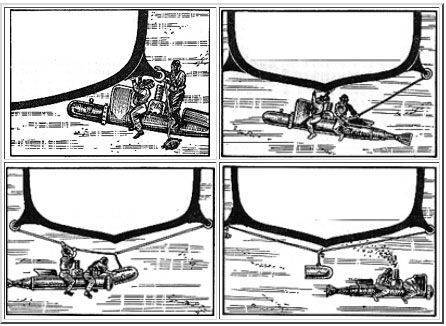
Installation scheme of the warhead (torpedo SLC)
The first SSB torpedoes were built by the middle of the 1943 of the year. At the time of the surrender of Italy, the 10-I MAC flotilla received only three such devices. Later eight more units were delivered. Plans to build a third batch of torpedoes from 16 were not implemented. Due to various problems, primarily due to the Allied attacks on the industry of the Italian Social Republic and numerous acts of sabotage, the number of SSB combat-ready torpedoes never exceeded 8-10 units.
The situation on the fronts was changing for the worse for the Axis. The Republic of Salo suffered defeat and was unable to plan full-scale sabotage operations. The exploitation of the Maiale torpedoes virtually ceased after the surrender of 8 September 1943 of the year. The three SSB torpedoes of the 10 fleet were not yet ready for use. As a result, all cash SLC and SSB were put on a joke, waiting for a convenient opportunity to use them.
However, the "Torpedoes from San Bartolomeo" could take part in the war. By the autumn of 1944, two such vehicles had been transferred to an operational submarine group based near the city of Castaña. 7 November this technique was going to use in battle. A specially equipped carrier ship was to deliver two torpedoes to the area of Livorno, where it was supposed to attack the Allied ships. However, divers, saboteurs never got to the goal. There was a breakdown on the carrier, which caused him to return to the base. The first case of combat use of SSB torpedoes did not take place. In the future, Italian saboteurs did not have the opportunity to test a new technique in action.
As the forces of the anti-Hitler coalition advanced, more and more new Italian military equipment became trophies. By the end of the war, the Anglo-American forces were able to capture all the human-controlled torpedoes of the new model available to the enemy. The SSB torpedoes in Venice were the first to fall into the hands of the British and Americans. Then they managed to capture the remaining two vehicles from Castagna. All this sabotage technique was captured safe and sound.
The allies did not refuse the opportunity to divide such trophies among themselves and study them carefully. After all the tests and inspections, the captured equipment was disposed of or went to museums. According to various sources, from two to seven SSB torpedoes have survived to date. All of them are museum exhibits and are stored in the United States and some European countries. Of particular interest is the fate of one of the captured torpedoes, which managed to continue its service. After the end of the Second World War, this unit was transferred to the Italian Navy and soon underwent a modernization. Operation of the updated SSB continued until the mid-fifties. After the service, this torpedo was transferred to the museum.
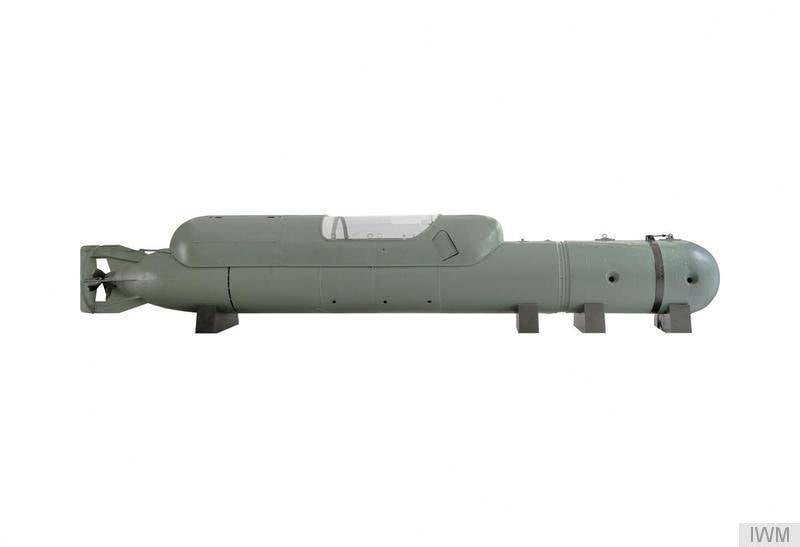
General view of the SSB torpedoes. Figure Iwm.org.uk
From the mid-thirties to mid-forties, fascist Italy developed two types of human-controlled torpedoes: SLC Maiale and SSB. The first of them were built in a large series, the fleet received about 80 such torpedoes. SSB appeared too late, due to which no more than a dozen vehicles were built. The combat service of two torpedoes was similarly formed. Older Maiale was able to participate in battles, as well as destroy and damage several enemy ships. The new SSB, in turn, only once got the opportunity to take part in sabotage, but this operation was disrupted due to a ship carrier failure.
The project of human-controlled torpedo Siluro San Bartolomeo is of great interest from the point of view stories and technology. Torpedo SSB was the last attempt of Italian engineers to change the course of the war with the help of sabotage underwater. However, this device appeared too late and could not affect the course of the war. Remaining torpedoes took their place in museums, where they remain to this day.
On the materials of the sites:
http://bratishka.ru/
http://digilander.libero.it/
http://iwm.org.uk/
http://navyworld.narod.ru/
Information